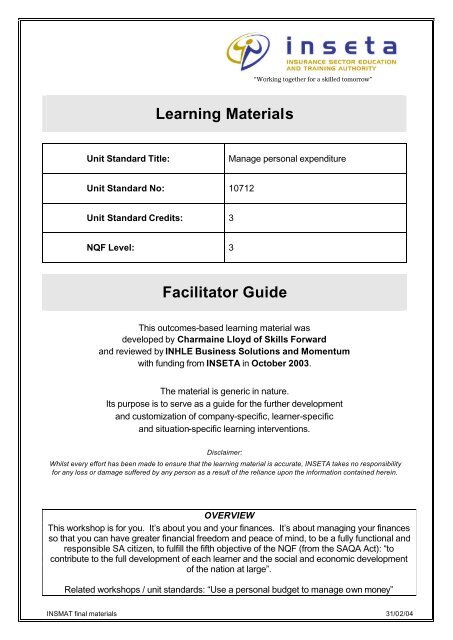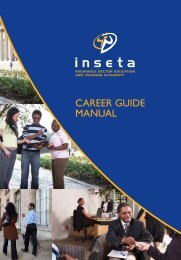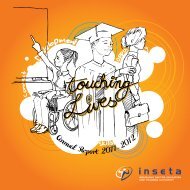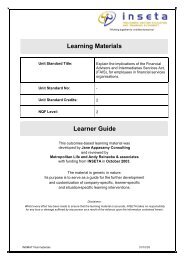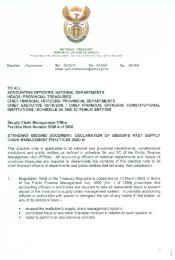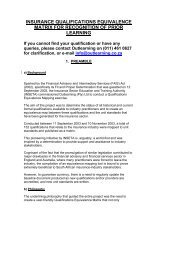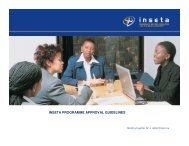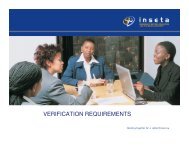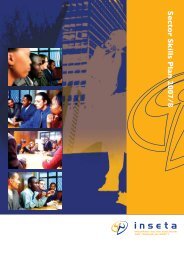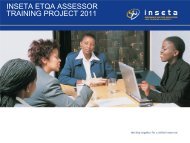Learning Materials Facilitator Guide - Inseta
Learning Materials Facilitator Guide - Inseta
Learning Materials Facilitator Guide - Inseta
You also want an ePaper? Increase the reach of your titles
YUMPU automatically turns print PDFs into web optimized ePapers that Google loves.
“Working together for a skilled tomorrow”<strong>Learning</strong> <strong>Materials</strong>Unit Standard Title:Manage personal expenditureUnit Standard No: 10712Unit Standard Credits: 3NQF Level: 3<strong>Facilitator</strong> <strong>Guide</strong>This outcomes-based learning material wasdeveloped by Charmaine Lloyd of Skills Forwardand reviewed by INHLE Business Solutions and Momentumwith funding from INSETA in October 2003.The material is generic in nature.Its purpose is to serve as a guide for the further developmentand customization of company-specific, learner-specificand situation-specific learning interventions.Disclaimer:Whilst every effort has been made to ensure that the learning material is accurate, INSETA takes no responsibilityfor any loss or damage suffered by any person as a result of the reliance upon the information contained herein.OVERVIEWThis workshop is for you. It’s about you and your finances. It’s about managing your financesso that you can have greater financial freedom and peace of mind, to be a fully functional andresponsible SA citizen, to fulfill the fifth objective of the NQF (from the SAQA Act): “tocontribute to the full development of each learner and the social and economic developmentof the nation at large”.Related workshops / unit standards: “Use a personal budget to manage own money”INSMAT final materials 31/02/04
WORKSHOP ASSUMPTIONSThe developers of this workshop have made the following assumptions in the design of it:? Learners have mathematical skills at level 2.? Learners have their own banking accounts and experience with loans and home loans. If it issuspected that they do not (i.e. school students, school leavers or new graduates) thefacilitator should conduct a pre assessment to find out existing knowledge and experienceand adapt activities and material accordingly. E.g. If they do not have own bank accountsthey can interview their parents about theirs as workshop pre-work.? Some activities include the use of a personal computer to meet the critical cross-fieldoutcome of “using science and technology”. These activities were included on theassumption that the workshops would be run in-house by companies who have PC learningcentres, or training providers who can provide access to learning centres. The facilitator canadapt the activities in instances where this is not the case.? In view of the above you will need to pre-assess learners’ PC literacy. The calculator issimple. They will need to know how to open and close windows and how to use a mouse.Manage Personal Expenditure 3 of 53<strong>Facilitator</strong> <strong>Guide</strong>Developed by Skills Forward for INSETA in November 2003
HOW TO USE THIS FACILITATOR GUIDEExplanation of the Different types of ActivitiesThe facilitator guide will walk you through the lesson plans. It contains information such as:? The Purpose of the activity - what the developer was aiming to achieve. Do not share thiswith the learners. Rather explain the outcomes that are being addressed by the lessons andactivities.? The process for the activities and possible variations.? How to debrief the activities during plenary.? Possible answers (where these are not obvious).Below is some information on the rational behind some of the activities and icons used in thelearner guide:Individual Reflection: In experiential and learner centred learning, learners needto reflect on their existing knowledge and experiences. Individual reflection isoften used to lead into the topic to warm the learners to the subject and exploretheir existing knowledge and attitudes about it. This method of learning iseffective for content of a personal nature. As a facilitator you must be careful notto make learners uncomfortable to share this personal information with thegroup. At the same time, however, you need to Plenary the exercises. Whendoing this you would discuss how the learners felt completing the exercises anddo some generic feedback.Manage Personal Expenditure 4 of 53<strong>Facilitator</strong> <strong>Guide</strong>Developed by Skills Forward for INSETA in November 2003
Paired activities provide an opportunity for learners to share their knowledgeand experience. It also gives them the opportunity to interact with other learnerson a more personal level, than in larger groups. As a facilitator you may want topair more experienced learners with less experienced learners so that the moreexperienced learners have an opportunity of sharing their ideas, and the learnerswho may be a bit reticent can gain confidence from the more experiencedlearners. If you have an uneven number of learners, one of the pairs will need tohave three participants. Ensure that if this is the case that everyone has a role toplay. For example, if it is a role play then get one of the three to be the observerand give the others feedback.Small group work gives learners the opportunity to get to know other people inthe workshop and exchange ideas. It also helps them to learn from each other’sexperiences and knowledge, and teaches them how to work as a team. You mayinterchange the groups so that they benefit from the whole groups’ experiencesand get to know each other. The size depends on number of delegates. Groupscan be of 3 – 8, depending on the size of the class and the activity. You mustensure that all learners participate in these discussions and activities. Dependingon the exercise it is beneficial to Plenary after the activities. Be careful not towaste time or allow the groups to become unfocused. Ensure that each group hasan opportunity to contribute to the Plenary. It is also effective to use peerassessment during these activities.Whole group activities are used to introduce the topics, for the plenary, and towrap up sessions.Manage Personal Expenditure 5 of 53<strong>Facilitator</strong> <strong>Guide</strong>Developed by Skills Forward for INSETA in November 2003
Reading: Although the material is designed to be experiential (which means theworkshop is experiential rather than content based), learners may need someknowledge to master the unit standard. Some of this reading will need to be donein the classroom and is provided in the readings.Further reading: We will also suggest books, articles and web sites where theycan further research and read up on the topic, either for their assignments or toexpand their knowledgeResearch: Learners may be required to further research information according tothe outcomes of the unit standard or for the research assignments as part ofsummative assessment activities.Key learning points: You should conclude each module by eliciting the keylearning points of that module from the learners. The learners have a spaceprovided in their learner guides to summarise these.Glossary: The designers have aimed to keep the use of language plain andsimple. However, where they feel that a word or term may need an explanation, ithas been indicated in red, and a glossary has been provided at the end of themodule to explain the word. We also want to encourage learners to expand theirvocabulary and you should encourage them to use the space provided to includeany other words that they have not understood. They should look up the meaningsof these words.Manage Personal Expenditure 6 of 53<strong>Facilitator</strong> <strong>Guide</strong>Developed by Skills Forward for INSETA in November 2003
UNIT STANDARD________________________________________________________________1. TITLE: Manage personal expenditure________________________________________________________________2. UNIT STANDARD NUMBER: 107123. LEVEL ON NQF: 34. CREDITS: 35. FIELD: Business, Commerce and Management StudiesSub-FieldFinancial Services – Insurance: Financial Literacy6. ISSUE DATE:7. REVIEW DATE:8. PURPOSE:Learners who achieve this unit standard can make more informed decisions with regard tothe management of personal expenditure.The qualifying learner is capable of:• Reconciling his/her personal bank statement.• Reconciling creditor accounts.Manage Personal Expenditure 8 of 53<strong>Facilitator</strong> <strong>Guide</strong>Developed by Skills Forward for INSETA in November 2003
• Demonstrating an understanding of the impact of a change in interest rates and makesinformed decisions in adjusting monthly repayments.• Understanding the impact of inflation on him/herself and how inflation is measured.9. LEARNING ASSUMED TO BE IN PLACE:There is open access to this unit standard. Learners should be competent inCommunication, Mathematical Literacy and Financial Literacy at NQF Level 2.10. SPECIFIC OUTCOMES AND ASSESSMENT CRITERIASpecific Outcome 1: Recognise and manage the items on a bank statement andcheck a bank statement for accuracy.Assessment Criteria1.1. Types of withdrawals and deposits shown on a bank statement are identified andlisted as debits or credits.1.2. The cost of each type of transaction is identified on a bank statement andsummarised in a table.1.3. Costs of transactions are investigated and compared for three different banks witha view to reducing bank charges.1.4. The concepts of stop orders and debit orders are explained and compared in atable.1.5. The concept of stale cheques is explained and an indication is given of the periodfor which a cheque is valid.1.6. The concept of RD (return to drawer) cheques is explained and an indication isgiven of the cost to both parties when a cheque is RD.Manage Personal Expenditure 9 of 53<strong>Facilitator</strong> <strong>Guide</strong>Developed by Skills Forward for INSETA in November 2003
1.7. The dates of transactions are explained in terms of their implications for clearanceperiods and cheques yet to be presented.1.8. An accurate record of deposits and withdrawals made in a month from ATM slips,cheques and other transactions are accurately reconciled to a bank statement, withan explanation for each reflected item.1.9. Internet banking is investigated and a summary is made of the costs, benefits, andrisks for this banking option.1.10. The risk associated with not managing and reconciling bank statements promptlyis indicated for own situation.Specific Outcome 2:Reconcile creditor statements and check for accuracyAssessment Criteria2.1. The types of debits and credits on creditor’s statements are investigated and listedfrom an authentic statement.2.2. The cost of credit on a typical creditor account is calculated as an annualpercentage.2.3. The costs and benefits of insuring creditor’s accounts are explained as a means ofmanaging risk.2.4. Options for recourse available to customers in cases of creditor fraud andunauthorised charges are explained and an indication is given how a customer canaccess help.2.5. The implications of non-payment, overpayment and late payment of creditoraccounts are summarised from the point of view of the customer and the creditor.2.6. A creditor’s s statement is accurately reconciled to records kept of purchases andpayments.2.7. The risk involved if creditors’ statements are not checked and reconciled promptlyis explained using examples.Manage Personal Expenditure 10 of 53<strong>Facilitator</strong> <strong>Guide</strong>Developed by Skills Forward for INSETA in November 2003
Specific Outcome 3:Demonstrate an understanding of the impact onpersonal spending of a change in interest rates.Assessment Criteria3.1. The capital and interest portions of a typical loan repayment are identified for threeexamples.3.2. The total amount paid over the life of a home loan is calculated for a typical homeloan at various rates of interest over 20 to 25.3.3. Typical home loan tables are analysed and the impact of changing interest rates,with constant repayments are depicted graphically.3.4. The alternatives of maintaining current installments or making an alternativeinvestment with the amount saved are compared and a decision is made on thebest action to be taken when interest rates are decreased for own situation.3.5. The advantages and disadvantages of an access type bond are investigated anda decision is made about the usefulness of this type of bond in own circumstances.Specific Outcome 4:Demonstrate an understanding of inflation and itsimpact on the individualAssessment Criteria4.1. The concept of inflation is explained with reference to a basket of goods and ownexperience.4.2. The purchasing power of R1 ten years ago, is compared to that of today, usingpersonal examples.Manage Personal Expenditure 11 of 53<strong>Facilitator</strong> <strong>Guide</strong>Developed by Skills Forward for INSETA in November 2003
4.3. The method of calculating the official inflation rate is explained and an opinion isformed as to its relevance to own situation.4.4. Alternative or personally more appropriate methods of calculating the rate ofinflation are considered and a system is devised for calculating ones own personalinflation rate.ACCREDITATION AND MODERATIONThis unit standard will be internally assessed by the provider and moderated by a moderatorregistered by INSQA or a relevant accredited ETQA. The mechanisms and requirements formoderation are contained in the document obtainable from INSQA,INSQA framework for assessment and moderation.RANGE STATEMENTThe typical scope of this unit standard is• The full range of debits and credits on bank statements including bank charges, intereston overdraft, cheque payments, debit/stop orders, ATM withdrawals, RD cheque fees,Internet banking transfers, direct deposits, cash and bank deposits and interest received.• Creditor account issues including interest free, costs of becoming club members,voluntary/involuntary insurance, automatic debits and acceptance of special offers, earlysettlement and late payments.• Creditors include credit cards, shop accounts, cell phones, telephone, electricity andwater accounts.• Capital and interest portions of loan repayments include payments on a bond, car,household and personal items.• Potentially fraudulent, automatic, or unnecessary charges on accounts and insurance.Manage Personal Expenditure 12 of 53<strong>Facilitator</strong> <strong>Guide</strong>Developed by Skills Forward for INSETA in November 2003
CRITICAL CROSS-FIELD AND DEVELOPMENTAL OUTCOMESThis unit standard supports the following critical cross-field outcomes at NQF Level 3:1. The learner is able to identify, solve problems and make decisions relating to his/hercurrent monthly spending2. The learner is able to communicate effectively using visual, mathematics and languageskills in the modes of oral and written presentation when evaluating his/her own bank andcreditor statements3. The learner is able to organise and manage him/herself effectively by managing bank andcreditor accounts.4. The learner is able to collect, organise and critically evaluate information relating to ownbank and creditor accounts.5. The learner is able to act as a responsible citizen in managing own finances.6. The learner is able to use technology such as ATM and Internet banking facilities andcalculating the amount payable over the life of a loan, medical aid provision and shortfalls,and use it to develop a contingency savings plan.Manage Personal Expenditure 13 of 53<strong>Facilitator</strong> <strong>Guide</strong>Developed by Skills Forward for INSETA in November 2003
LEARNING AND ASSESSMENT MAPSPECIFIC OUTCOMES AND ASSESSMENTCRITERIAFor Unit Standard 10712 Manage personalexpenditure Module ActivityResearchAssignmentCompetencyratingSpecific Outcome 1:Assessment Criteria1. Types of withdrawals and depositsRecognise and manage the items on a bank statement and check for accuracy.shown on a bank statement areidentified are listed as debits or credit.2. The cost of each type of transaction isidentified on a bank statement andsummarised in a table3. Costs of transactions are investigatedand compared for three different bankswith a to reducing bank charges4. The concepts of stop order and debitorders are explained and compared intable5. The concept of stale cheques isexplained and an indication is given ofthe period for which a cheque is valid6. The concept of RD (Return to Drawer)cheques is explained and indicationgiven of the cost to both parties whena cheque is RD7. The dates of transactions areexplained in terms of their implicationsfor clearance periods and cheques yetto be presented8. An accurate record of deposits andwithdrawals made in a month from ATMslips, cheques and other transactionsare accurately reconciled to a bankstatement, with an explanation foreach reflected item.57347713332Manage Personal Expenditure 14 of 53<strong>Facilitator</strong> <strong>Guide</strong>Developed by Skills Forward for INSETA in November 2003
SPECIFIC OUTCOMES AND ASSESSMENTCRITERIAFor Unit Standard 10712 Manage personalexpenditure Module Activity9. Internet banking is investigated and asummary is made of the costs,benefits, and risks for this bankingoption10. The risk associated with not managingand reconciling bank statementspromptly is indicated for own situationSpecific Outcome 2:Assessment Criteria1. The types of debits and credits oncreditors statements are investigatedand listed for an authentic statement2. The cost of credit on a typical creditoraccount is explained as a managingrisk.3. The costs and benefits of insuringcreditor’s accounts are explained as ameans of managing risk4. Options for recourse available tocustomers in cases of creditor fraudand authorised charges are explainedand an indication is given how acustomer can access help.5. The implications of non-payment,Reconcile creditor statements and check for accuracyoverpayment and late payment ofcreditor are summarised from the pointof view of the customer and thecreditor6. A creditors statement is accuratelyreconciled to records kept ofpurchases and payments7. The risk involved if creditorsstatements are not checked andreconciled promptly is explained9617191220141516ResearchAssignment44CompetencyratingManage Personal Expenditure 15 of 53<strong>Facilitator</strong> <strong>Guide</strong>Developed by Skills Forward for INSETA in November 2003
Specific Outcome 3:in interest ratesAssessment Criteria1. The capital and interest portions of atypical loan repayment are identifiedfor three examples2. the total amount paid over the life of ahome loan is calculated for a typicalhome loan at various rates of interestover 20 – 253. Typical home loan tables are analysedand the impact of changing interestrates, with constant repayments aredepicted4. The alternatives of maintaining currentinstallments or making an alternativeinvestment with the amount saved areDemonstrate an understanding on the impact of personal spending of a changecompared and a decision is made onalternative investment with the amountsaved are compared and a decision ismade on the best action to be takenwhen interest rates are decreased forown situation.5. The advantages and disadvantages ofan access type bond are investigatedand a decision is made about theusefulness of this type of bond in owncircumstances.22222223ResearchAss 6Manage Personal Expenditure 16 of 53<strong>Facilitator</strong> <strong>Guide</strong>Developed by Skills Forward for INSETA in November 2003
COMPETENCIES REQUIRED OF FACILITATORS FOR THIS WORKSHOPCompetencies: Must be accredited in the unit standardKnowledge of:Skills to:Attitudes and values thatshow:• Adult learning principles• Experiential <strong>Learning</strong>• Outcomes Based Education• Assessment Practices• The National Qualifications Framework• Facilitate learning• Manage diversity in the training room• Lead the learners to discovery• Time Management• Listening Skills• A concern for all learners to achieve competence• A commitment to keeping the material up to date• Respect for the learners and their diverse backgrounds• A willingness to learn from the learnersManage Personal Expenditure 17 of 53<strong>Facilitator</strong> <strong>Guide</strong>Developed by Skills Forward for INSETA in November 2003
CRITICAL CROSS FIELD OUTCOMESThe Critical Cross Field Outcomes (CCFO’s) have been incorporated into the learning activities.Inclusion of CCFO’s into a learning workshop exposes learners to the competencies of aspecific topic, as well as to critical skills that will develop the learner as a whole person andenable him/her to develop the capacity for lifelong learning. The table below includes thefollowing Critical Cross Field Outcomes1. Solving problems2. Working as a team3. Organising and managing oneself4. Collecting, organising and critically evaluating information5. Communicating effectively using visual, mathematics and language skills6. Using science and technology7. Demonstrating an understanding of the world as a set of related systems8. Exploring a variety of strategies to learn more effectively9. Participating as a responsible citizen in the life of local, national and global communities10. Being culturally and aesthetically sensitive11. Exploring education and career opportunities12. Developing entrepreneurial opportunitiesManage Personal Expenditure 18 of 53<strong>Facilitator</strong> <strong>Guide</strong>Developed by Skills Forward for INSETA in November 2003
Activity 1 2 3 4 5 6 7 8 9 10 11 121. X x2. X X3. X X X4. X X5. X X6. X X X X7. X X X X8. X X X X X9. X X X X X X X10. X X X X11. X X X X X12. X X X13. X X X X X X14. X X15. X X16. X X X17. X18. X19. X20. X X X X21. X X X X X22. X X X23. X X XManage Personal Expenditure 19 of 53<strong>Facilitator</strong> <strong>Guide</strong>Developed by Skills Forward for INSETA in November 2003
PRE-WORK FOR WORKSHOP? Load the ERA calculator on the PC in your PC learning centre.? If you do not have a PC learning centre. Change the activitiesin module three to be manual rather than PC based.? Depending on time available for the workshop, give ActivityOne – the collage, as pre work to the learners. I.e. send it tothem at least two weeks before the training commences.? Activity three can also be allocated as pre-workshop work. Ifyou decide to do this, ensure that learners receive the self-testat least two weeks before the training.OPENING AND WELCOMEOverall Objective:30 MinutesDiscuss the unit standard, confirm outcomes; set tone for training; orientparticipants to class and facility.• Welcome the group.• Introduce yourself.• Explain workshop outcomes.• Conduct icebreaker.• Discuss Hygiene issues, breaks, smoking, where to find certainfacilities, cell phones.• Ask them to share what their expectations would be for attending thisworkshop/module. Write their answers on the flipchart. Once everyonehas contributed check which of the expectations will be met with thisworkshop/module and which will not.OutcomesChoose a suitableicebreaker (Choiceof ice Breakers atthe end of the<strong>Facilitator</strong>’s <strong>Guide</strong> oruse own)• Discuss compilation of POE. How they will have to put copies of allactivities done in the workshops in their POE’S as evidence of formativeassessment.Manage Personal Expenditure 20 of 53<strong>Facilitator</strong> <strong>Guide</strong>Developed by Skills Forward for INSETA in November 2003
INTRODUCTIONActivity One: Individual30 Minutes(Note this could have been given as pre-work for the workshop)Purpose of exercise: The reason for the collage is to create a visual pictureof how the learners feel about their financial situation. By constructing itvisually you will be enabling them to express their feelings. At the end of theworkshop they will be required to look back at this collage and decide if this istheir desired financial picture. For their summative assessment they will putan action plan in place to ensure that they change their financial picture to amore empowering one.Collage – an art form in which different materials such as bits of newspapers,magazines, drawings etc. are arranged to form a visually pleasingarrangement. In the Learner’s <strong>Guide</strong>s there are examples taken from theWorld Wide Web.Magazines,newspapers, thatcan be cut upcolour pens,Scissors for eachlearnerGlue for eachlearnerPaper for eachlearnerLearner’s <strong>Guide</strong>sProcess: Explain to learners what they have to do.Note. This activity will appeal to your visual learners. Most of the remainingactivities are mental processing, so allow these learners an opportunity toexpress themselves creatively and visually.Activity Two: Individual reflection30 MinutesLearner’s <strong>Guide</strong>sPurpose of exercise: To expand on the previous activity. Learners will nowtranslate their collage into words. How do they feel about money and theirfinancial situation? This can also be done as pre-workshop work with thecollage.Manage Personal Expenditure 21 of 53<strong>Facilitator</strong> <strong>Guide</strong>Developed by Skills Forward for INSETA in November 2003
Variations: If you are pressed for time, this exercise can be forfeited, and youcan move straight to the plenary by asking the whole group to randomlyexpress what their collages mean and how they feel about money.Process: Learners answer the questions posed in the activity regarding theirfeelings about money and their financial situations.FlipchartPlenary:Ask questions such as:10 Minutes? How did you feel about that activity?? Did creating a picture of your finances create a desire for change?? Did anyone share a picture that you envy? A picture that looksmore peaceful and in control than yours?? What would you like your picture to look like?? Did you learn anything from the discussions in your group?? Was there anything that you did not feel comfortable with?Wrap up by telling the learners that in the Financial Services Sector staff areexpected to help take care of and grow other peoples’ wealth. Theiremployers expect them to take care of their own finances too. Manyinsurance companies do ITC checks before employing staff, as they do notwant to have staff that cannot manage their finances. It is critical for staff tomanage their finances, not only for their peace of mind, but to be able to growtheir careers in the sector.FlipchartManage Personal Expenditure 22 of 53<strong>Facilitator</strong> <strong>Guide</strong>Developed by Skills Forward for INSETA in November 2003
ConclusionSummarise outcomes of introductory module15 MinutesAsk learners to each write down what they believed the outcomes to be andthen write these down on the flipchart, ensuring that the flipchart page is wellheaded. Once they are all written down, comment if necessary, add to the listif appropriate and stick the flipchart page up on the wall. This summary of theKey <strong>Learning</strong> Points for this module will form a part of the conclusion of theworkshop.OutcomesMODULE 1 - BANKINGOverall Objective: Confirm outcomesModule Outline: This module will assist you• Understand the various banking services• Explain why it is necessary to check bank statements• Check your bank statement and manage the items on the bankstatement• Understand the need to check bank statements• Identify the items on a bank statement and recognize them as debitsand creditsManage Personal Expenditure 23 of 53<strong>Facilitator</strong> <strong>Guide</strong>Developed by Skills Forward for INSETA in November 2003
Module 1, Lesson 1My banking IQActivity Three:10 Minutes(Note: this activity may also have been given as pre-workshop work)Learner’s <strong>Guide</strong>sPurpose of exercise: To introduce learners to the concepts of bankingproducts. To get them to start thinking about their current banking behaviourand how it can cost them unnecessary money if they do not manage itproperly.Variations: This activity will not be appropriate if learners do not own a bankaccount. It could be restructured as an interview for their parents or afriend/relative that does have a banking account to determine others bankingbehaviour and to make inferences.Process: Advise the participants to fill in the questionnaire. Walk around theroom, ensuring that all learners understand the questions and the how to scoretheir answers. Based on the questionnaire, learners record changes that theyare going to make regarding their banking practices.Manage Personal Expenditure 24 of 53<strong>Facilitator</strong> <strong>Guide</strong>Developed by Skills Forward for INSETA in November 2003
Module 1, Lesson 2Choosing the right bank & banking productsActivity Four: Paired work15 Minutes2Learner responsesPurpose: Do learners know why they bank with a certain bank? Brandloyalty? Convenience? Are they just banking there because their parentsbanked there? Lowest charges? Do they know what charges they arepaying? This activity gets learners to start thinking that there may bealternatives.Learners <strong>Guide</strong>sProcess: Learners answer the questions in their manuals on page 19 inpairs, and the plenary follows.Plenary: Most people do not know what they are paying in bank charges. Byknowing your bank charges you can save a lot of money. You can evennegotiate bank charges with your bank as your bank would rather negotiatethan lose a client. Get them to sign the pledge that they will find out what theircharges are and manage them.Manage Personal Expenditure 25 of 53<strong>Facilitator</strong> <strong>Guide</strong>Developed by Skills Forward for INSETA in November 2003
Module 1, Lesson 2Activity Five: Paired Activity15 MinutesPurpose: To check learners existing knowledge of bank statements. And tomeet various ac’s. Through discussion they will also realise what they do notknow about bank statements, and what they need to find out. During theplenary they will find out answers to questions they do not know. It is hoped itwill pique their curiosity to find out more about their bank. The knowledgefrom this exercise is a requirement for the next activity.Process: Divide the group into pairs. Learners work through the questions onpages 20 and 21, and the plenary follows.Plenary: Go through the questions together, eliciting answers from the group.Answer any additional questions they might have.Learners <strong>Guide</strong>Module 2, Lesson 3Activity Six: Small GroupUnderstand the need to check bank statements15 MinutesPurpose: To create an awareness of the dangers of not checking bankstatements and the losses an individual can incur. To become committed toreconciling bank statements as opposed to leaving them unopened.Process: Explain process to learners.• Learners to read through the case study in the Learner’s <strong>Guide</strong>• In groups, discuss the questions at the end of the case study• In small groups, discuss why it is important for account holders toPlenary:balance their statements every month and to relate personalexperiences about similar incidences.• Ask anyone if they have an interesting story to relate of a similarincident. What was the outcome?• What can we learn from the case study?• Are the banks at fault?• Ask them to sign the pledge on page 25 to be more committed to theirmoney management by reconciling their personal accounts.Manage Personal Expenditure 26 of 53<strong>Facilitator</strong> <strong>Guide</strong>Developed by Skills Forward for INSETA in November 2003Learner’s <strong>Guide</strong>
Module 1, Lesson 4Activity Seven: Small Group40 MinutesChecking the Items on a bank statementPurpose: Identify the items on a bank statement and recognise them asdebits or credits. Identify the costs of the transactions.Process: Allocate learners into groups of 3 - 6. Ensure that everyoneunderstands how to do the activity by either walking around the room, or doingan example with the large group first.Plenary: Check answers. Discuss what debit orders, stop orders, etc are.Notes are at the end of the module.Learner’s <strong>Guide</strong>? Identify the withdrawals and deposits on the statement and place them inthe table in the Learner’s <strong>Guide</strong> according to whether they are debits orcredits? Identify the costs of each transaction and place them into the BankCharges column? Now let the groups report back on how they would advise Mrs. Naidoo toreduce her banking costs with World Bank.Activity Eight: Small Group40 MinutesPurpose: Continuing from the last exercise to see if learners can analyse astatement and bank information to reduce charges. A more complex activityas they need to refer to the statement and the bank’s policy and makedecisions.Process: Keep learners in existing groups. Ensure that everyoneunderstands how to do the activity by either walking around the room, or doingan example with the large group.Variation: You could ask them to even add up what the cost savings would beif their suggestions are taken and award a prize to the group whose (correct)suggestions result in the largest cost saving.…(Continued on next page)Learner’s <strong>Guide</strong>Learners responsesManage Personal Expenditure 27 of 53<strong>Facilitator</strong> <strong>Guide</strong>Developed by Skills Forward for INSETA in November 2003
Plenary: Ask each group to provide suggestions. Suggested answers:• Too many cash withdrawals: Mrs. Naidoo should rather check her cashrequirements once per week and draw accordingly – will reducecharges.• She should plan her cash requirements better: She banked R250 cash,and then used her debit card on 18 June. She should have held ontothe money for a few days.• Should only withdraw from her own bank’s ATM.• Should ask her bank to increase her Overdraft to avoid penalties orshould avoid overdrawing on her account.• Should avoid over the counter withdrawals and deposits.• Should consider utilizing her Internet banking option more – she hasonly used it once and she pays R20 per month for it.• Also she could use her Internet payment facility instead of cheques –much cheaper.• Could consider going to option one and only pay R30 per month.• She should only use one bank statement from ATM per month –otherwise she should draw statements from her Internet for free.Introduce: Research assignments One, Two & Three. Explain theassessment criteria. Field questions and concerns. Explain how to compilePOE. Remind them that all previous formative assessment activities mustalso be included in the POE.Warning: Learners may be sensitive about this, but it is a requirement of theunit standard. The assessor may wish to draw up dummy statements andtransaction slips for the assessment process to counteract the sensitivities,but then the learning is not contextualised to the learner’s own situation.Learner’s <strong>Guide</strong>Learner’s own bankstatements andcheque bookManage Personal Expenditure 28 of 53<strong>Facilitator</strong> <strong>Guide</strong>Developed by Skills Forward for INSETA in November 2003
Module 1, Lesson 5Internet BankingActivity NineNote: To keep this module up to date go tohttp://computerhacker.newstrove.com/ for all the current Computer HackernewsAlso read local news about any internet related fraud.Learner’s <strong>Guide</strong>Activity Nine: Hack Attack60 MinutesPurpose: For the learners to make informed decisions about theadvantages, disadvantages and threats of internet banking. It will also givethem an opportunity to critically think about the issue from a number ofperspectives. The readings provided give a balanced view. The banks say itis safe if we practice safe internet usage. The hackers say they can get intoanything. It will also highlight why companies are so strict about e-mail andinternet usage. This activity also allows for many of the CCFO’s to beincorporated as per the grid in the beginning of your facilitator guide. It willalso engage your auditory and tactile learners.Process: Provide instructions for the activity as per instructions in learnermanual. They are really going to have to work as a team here because thereare many articles to read so suggest that each team member reads onearticle and provides feedback to the team. You will have to play the role ofFelicia and ask controversial questions about internet banking. And allow thefloor to ask questions. Make it fun.Manage Personal Expenditure 29 of 53<strong>Facilitator</strong> <strong>Guide</strong>Developed by Skills Forward for INSETA in November 2003
Variations:• You can ask the learners to present their arguments for the viewersgraphically on a poster.• Plant a mole in the audience. Someone who is quite disruptive.Almost a character off a Larry King Live set, who doesn’t agree withanything. This will give the learners an opportunity to deal with peoplewho do not agree with their opinions. You will have to facilitate itcarefully.• Peer Assessment: The activity lends itself to peer assessment. Atthe end of the activity ask the learners to rate each other on variousteam dimensions (listening, co-operation, respect, etc) to be includedin the POE as a CCFO.Plenary:Ask them what they have learned about internet safety.Try to elicit that internet banking can be a useful tool that needs to be usedresponsibly. But that the choice remains a personal one. Bring it back tothe workplace and let them see why it is so important not to send Spam andjunk e-mails around. (You could hand out the company Internet and emailusage policy).Ensure that they write down all the learning points to include in the POE inthe worksheet provided.<strong>Learning</strong> pointsConclude:Refer them to the personal reflection on page 48 and give them a fewminutes to make a personal decision about internet banking. And read aboutother forms of electronic banking.Learner’s <strong>Guide</strong>Manage Personal Expenditure 30 of 53<strong>Facilitator</strong> <strong>Guide</strong>Developed by Skills Forward for INSETA in November 2003
Module 1 Review10 MinutesConclude the module by asking all participants to complete the modulereview form. You may also want to make use of the review activitiessuggested at the back of the facilitator guide. Tell them that they are to dothe further readings in their own time.MODULE 2: CREDITOverall Objective: Confirm outcomes for the module.15MinutesSuggested introduction to module: Video record a few advertisements forcredit cards, fly now pay later, etc from TV. Play these for the learners as anintroduction. Begin with a discussion about how the consumer industry luresthe consumer to purchase things that they do not have money for today. Askthem when credit is a good option. Try to elicit from learners that credit canbe a good option when we use it to invest in our future, e.g. a home thatappreciates in value, or in our education. Explain that this module will look atcredit, the implications of credit (interest).FlipchartAny issues that arediscussed – youmay want to referbackManage Personal Expenditure 31 of 53<strong>Facilitator</strong> <strong>Guide</strong>Developed by Skills Forward for INSETA in November 2003
Module 2Activity Ten: Reflective Thinking10 MinutesPurpose: to get learners to think about their attitudes towards debt. To createa need for them to do this module and to change their behaviours if applicable.Process. Tell them to do the test and then read the short readings providedon their own. Assure them that they do not have to share their information withanyone.Learner’s <strong>Guide</strong>Module Two, Lesson SevenThe true cost of debtActivity Eleven30 MinutesPurpose: To explain the true cost of debt. That interest (and other hiddencosts such as insurance) is built into the price of goods bought on credit or HP.Process: Refer pairs to the activity, give them the “Supersavers” handout,and ask them to complete the worksheet in the workbook. If required do thefirst example with them.Learner’s <strong>Guide</strong>Plenary: Discuss Answers. Ask them if it is worth buying non-essential itemson credit (NO). Ask them why the store or bank charges interest: Possibleanswers:• The store and bank also need to make money• During the period of the repayment inflation may rise, so they have tocover their potential losses• Insurance cover is built into the prices (in case the client defaults onpayment)• The money is being loaned from somewhere else, so the store orbanks are covering their interest payments.• The item is not really on sale.Manage Personal Expenditure 32 of 53<strong>Facilitator</strong> <strong>Guide</strong>Developed by Skills Forward for INSETA in November 2003
Module Two, Lesson EightCredit InsuranceActivity TwelvePurpose: To experientially discover what credit insurance is and decide forthemselves if it a good option given a particular scenario.Learners <strong>Guide</strong>sProcess: As per learner guide.Plenary: Ask each group to volunteer answers. There are no right or wronganswers as to whether the subject in the case study should take theinsurance:• Ms. Ho has adequate life cover already, and no dependents, but itcould be argued that at R35 per month she could have her debt paidon getting disability and dread disease (free of underwriting). Variousarguments. This activity will allow the learner to practice some criticalthinking and debating skills.Flipchart• Mr. Ferreira has more dependents and less life and ancillary cover andshould consider the cover more seriously.• Ms Mhlapo should consider the cover most seriously as she has nocover and it is very cheap for her.The objective is not that they are right or wrong, but that they can make adecision. For the remaining questions, the answers are either right or wrong.What is credit life insurance?Cover that the borrower extends to the lender to ensure that in the event of aspecified unforeseen event (death, disability, retrenchment, etc); the borrower’sdebt will be settled. (this is usually underwritten by a third party, decreasingterm assurance, and free of underwriting)What are the advantages of this cover?• Free of underwriting• Cheap• Debt written off in an emergency (Retrenchment, Disability, Accident, etc)• Don’t leave debt behind to your loved onesManage Personal Expenditure 33 of 53<strong>Facilitator</strong> <strong>Guide</strong>Developed by Skills Forward for INSETA in November 2003
What are the disadvantages of this cover?Decreasing term (no values accumulate)Many exclusions for pre-existing conditions)Not customised to individual needsTakes three months on retrenchment to be paid outWhy do you think the creditor would be very eager to insist that you takethe covered even if it is not in your interest?They do not want to wait all the months it takes for the estate to be woundup in the event of death or insolvent estates in event of retrenchments anddisabilities.FlipchartAnswersModule 2, Lesson 8Activity Thirteen:10 MinutesPurpose: To make the learning personal.Process: Refer them to learner guide and ask them to complete the activityas instructed. They may need to do some investigation outside the workshopas it will involve referring to their creditors.Learner’s <strong>Guide</strong>Module 2, Lesson 9Paying CreditorsActivity Fourteen:30 MinutesPurpose: To wrap up the learning. To contextualise the importance of a goodcredit record to the insurance industry. To see the importance of having agood credit record.Learner’s <strong>Guide</strong>Process: Allocate pairs and give instructions for activity.Plenary: Go through the worksheet on pg70. Elicit answers from the groupand clarify and misunderstandings.Manage Personal Expenditure 34 of 53<strong>Facilitator</strong> <strong>Guide</strong>Developed by Skills Forward for INSETA in November 2003
Module 2, Lesson 9Activity Fifteen:40 MinutesPurpose: Often people cannot pay their debts, but don’t face theirresponsibilities out of fear or embarrassment. This just gets them into moretrouble. This activity is designed to give learners an opportunity to face theirfears in a safe setting by role calling a telephone call to a creditors departmentto ask for leniency on their outstanding payments. The role-play also meetssome CCFO’s.Process. Explain the role-play and why it is necessary. Half the class mustbe Mr. Brown. He must request to reduce monthly payments to R300. Tellthem to read the tips for negotiation. Explain that whilst these are high-leveltips for negotiation, they can take ten minutes to leave the room to prepare forthe telephone call. Whilst they are out of the room prepare Group B who willbe the creditor’s clerk to take the call. Prompt them as follows:Learner’s <strong>Guide</strong>Tell them that they must be polite but that their computer system is indicatingthat they cannot reduce the payments to R300 per month. But that if he paysR400 per month and accepts that his credit will be halted until he is fully paidup, you can accommodate him. If he persists, compromise at R350 permonth.Plenary: Ask the learners how it felt to phone and ask for an extension. Letthem discuss their feelings. How the negotiation went. How it felt when theperson on the other side said “No”. Ask anyone if they just gave up to astraight “no”. Ask them why” they didn’t use the suggested “batna” techniquesin the notes? Was it that scary? Conclude that creditors usually appreciatethat an effort is being made and prefer to avoid costly legal action.Flipchart any keylearning points.Activity Sixteen40 minutesPurpose: To give learners an opportunity to explore the consequences of notpaying debt from the viewpoint of the debtor and the creditor.Process: Allocate the learners into two groups. Ask one group to prepare theconsequences of non-payment or underpayment for creditors and one groupof non-payment or underpayment for debtors.Manage Personal Expenditure 35 of 53<strong>Facilitator</strong> <strong>Guide</strong>Developed by Skills Forward for INSETA in November 2003Learner’s <strong>Guide</strong>Learner’s <strong>Guide</strong>Pg 64-67
Plenary: Elicit answers from learners.Module 2, Lesson 10Activity Seventeen:20 MinutesChecking the Items on a creditor statementPurpose: Identify the items on a creditor statement and recognise them asdebits or credits.Process: Allocate learners into pairs. Ensure that everyone understands howto do the activity by either walking around the room, or doing an example withthe large group first.Plenary: Check answers with the group.Introduce: Research assignment Four. Explain the assessment criteria.Field questions and concerns. Explain how to compile POE. Remind themthat all previous formative assessment activities must also be included in thePOE.Learner’s <strong>Guide</strong>Learner’s <strong>Guide</strong>Activity EighteenIndividual Reflection15 MinutesPurpose: To contextualise the learning that has taken place to the learnersown situation so that it has relevance.Learner’s <strong>Guide</strong>Process. Refer learners to exercise and tell them this is personal. They donot have to share insights.Module 2, Lesson 11Activity Nineteen:Cost of credit as an annual percentage15 MinutesPurpose: To provide learners with an opportunity to calculate credit as anannual percentage – which would emphasise the cost of credit.Process: Allocate learners into pairs. Ensure that everyone understands howto do the activity.Manage Personal Expenditure 36 of 53Plenary: Check answer with the group. <strong>Facilitator</strong> <strong>Guide</strong>Developed by Skills Forward for INSETA in November 2003Answer = 3000 x 0.18 x 6 / 12 – R270 interestLearner’s <strong>Guide</strong>
Module 2, Lesson 12Activity 20:40 MinutesCreditor FraudPurpose: To alert learners to the very real possibility of becoming victims ofcreditor fraud, and provide options for recourse in these cases.Learner’s <strong>Guide</strong>Process: Divide learners into pairs. They are to read the articles, and thenanswer the questions in their manuals.Plenary: Go through the worksheet questions together, eliciting the answersfrom the group. Answer any additional questions they might have.Module 2 Review10 MinutesConclude the module by asking all participants to complete the module reviewform. You may also want to make use of the review activities suggested atthe back of the facilitator guide. Tell them that they are to do the furtherreadings in their own time.Manage Personal Expenditure 37 of 53<strong>Facilitator</strong> <strong>Guide</strong>Developed by Skills Forward for INSETA in November 2003
MODULE THREEINFLATION AND INFLATION RATESOverall Objective: Confirm outcomes for the module.15 MinutesLesson 10What is inflation?The purpose of this module is to show how inflation impacts on interest bearingpayments:It relates to Outcomes 3 and 4 of the Unit standard. We start with inflation,because inflation impacts on the interest.Activity Twenty One90 MinutesNote: Before facilitating this module you must ensure:• That you know how to do the calculations correctly• That you have a number of examples to give the learners• That you have visited the web siteshttp://www.statssa.gov.za/default3.asp and checked what the currentinflation rate is for the month• That you have updated the learner guides appropriatelyIntroduction: Ask learners what inflation is. Write answers on flipchart.Refer back to the flip chart at the end of the module to see if there have beenany changes to their ideas.Inflation means that your money won’t buy you as much today as it didwhen you didn’t have any – anonymousTell them the current inflation rate (as at August 2003 it is 5,1%). Ask them ifthey agree. There should be some heated debate.Manage Personal Expenditure 38 of 53<strong>Facilitator</strong> <strong>Guide</strong>Developed by Skills Forward for INSETA in November 2003
Purpose: Most people watch the news and hear that the inflation has gone upby 5,1%. However when they observe inflation in their personal lives it feelsmuch more than that. This introductory activity will confirm this perception.The examples are real price increases experienced by the writer from 2002 –2003, which are more than 5,1%. (As they progress through the module, theywill see STATS SA’s logic)Process: As per learner guide. Tell them to do the exercises in pairs. Theywill need calculators. You may need to do the first example with them.Learner’s <strong>Guide</strong>? They will calculate that the actual inflation on bread is: 11.13%, on milk is29.44%, and mealie meal is 5.13%.? Go through the activities with the learners. Stopping frequently to discuss,give examples, and answer questions. Follow the process in the guide.? Brainstorm the effects of inflation as a large group (suggested answer ashandout at back of guide)Learner’s <strong>Guide</strong>? Close the lesson with the learners, getting up to find someone who is likethey are. The objective of this exercise is to get them up and moving.They have been sitting for too long and processing complex information.This is an opportunity to get the tactile learners to move and for them tomingle. Of workshop you can sum it up with: “Do you see that people havedifferent needs”. So whilst the basket of goods may not look like itaccurately reflects your basket, it reflects that of the majority of SouthAfricans.Manage Personal Expenditure 39 of 53<strong>Facilitator</strong> <strong>Guide</strong>Developed by Skills Forward for INSETA in November 2003
Close this section by explaining Research Assignment Five. Explain theassessment criteria. Field questions and concerns. Remind how to compilePOE. Remind them again that all previous formative assessment activitiesmust also be included in the POE. Research current prices against the priceson the till slip. But don’t limit them to this suggestion. They may have far morecreative ideas for Mr. Manuel.Note: A till slip from 2002 is included at the back of facilitator guide. It mayassist the learners to do their own inflation formulae. I.e. they can go andcompare those prices to current prices.Learner’s <strong>Guide</strong>sModule 3, lesson 14Inflation rates and LoansActivity Twenty TwoPurpose: As per assumptions stated upfront, these activities need to bedone on PC. Learners will be required to do three activities as explained inthe learner guide.Learner’s <strong>Guide</strong>sP.C.’s requiredProcess: Learners must be shown how to use the amortization tables fromthe ERA calculator. DO first example as a large group activity.Plenary: Go through the answers with the learners and answer anyquestions they might have.Manage Personal Expenditure 40 of 53<strong>Facilitator</strong> <strong>Guide</strong>Developed by Skills Forward for INSETA in November 2003
Module 3, Lesson 14Activity Twenty ThreePurpose: The alternatives of maintaining current installments or making analternative investment with the amount saved are compared and a decision ismade on the best action to be taken when interest rates are decreased.Process: Divide the learners into pairs. They will need to read the case studyand two scenarios, and then decide from the options available, which is thebest to take. They will need to substantiate their answers.Plenary: Get the responses from all the sets of pairs, and summarise theirresponses on the flipchart. Then ask them to read the article which followsthe exercise on pg 99.Introduce: Research assignment Six. Explain the assessment criteria.Field questions and concerns. Remind how to compile POE. Remind themagain that all previous formative assessment activities must also be included inthe POE.Close the workshopManage Personal Expenditure 41 of 53<strong>Facilitator</strong> <strong>Guide</strong>Developed by Skills Forward for INSETA in November 2003
ICE BREAKERSSource: Reprinted with permission from Results Through Training, www.RTTWorks.comTopic lead-in questions can be answered collectively or individually. Use topic lead-ins liberally:it is appropriate to use them in every session, and you can use both types in a single session.Group ActivitiesGroup lead-ins are particularly useful for introducing the topic, discovering what is already knownand activating that prior knowledge. Here are some examples:Word TreeGenerate a list of words related to the topic. For example, in a health and safety workshop, askparticipants to give you words related to the phrase, "hazardous materials." Participants maysuggest: 'dangerous,' 'corrosive,' 'flammable,' 'warning,' 'skull and crossbones,' etc. Write allsuggestions on the board, clustering by theme where possible. You can use this opportunity tointroduce essential terms, too.Multiple Choice or True/False QuizRather than giving participants a multiple choice or true/false quiz at the end of a session, trygiving it at the beginning. As facilitator, you can walk around and discretely scan participants'responses -- this can help you to identify where to focus your attention during the training. Checkthe answers with the group at the end of the session.Individual Lead-In QuestionsIndividual lead-in questions are designed to identify individual learning needs and goals,encourage the sharing of information and resources, and/or surface resistance to learning.Participants can respond to questions in a predetermined order (e.g., left to right around theroom), or popcorn-style, by volunteering responses in random order. If you let participants speakin random order, remember that one of the purposes of this activity is to get people talking, so tryto ensure that everyone in the group makes a contribution.Here are some topic lead-in suggestions:• State one or two "burning questions" you hope will be answered in this session.• Describe one strategy/resource you have successfully employed recently (relevant to thetopic of the meeting/training).• State your personal definition of the topic (e.g., in customer service training, "CustomerService means...").The following lead-ins are particularly useful when the subject matter challenges establishedbeliefs or practices:• State your opinion on the topic. ("I think...")Manage Personal Expenditure 42 of 53<strong>Facilitator</strong> <strong>Guide</strong>Developed by Skills Forward for INSETA in November 2003
• Complete a phrase or phrases (e.g., in a customer service training on handling customercomplaints, "A customer service representative should NEVER respond to a complaintby...").To encourage free-flow participation, ask participants to listen to all contributions, but reservetheir comments for discussion later in the session.The Hat TrickThis is an icebreaker for groups that know each other well. Ask each participant to write his orher name on a small piece of paper. Collect all the names in a hat. Ask each person to pick aname out of the hat. Give each person a turn to stand behind the person whose name he or shedrew and give the following information:• A hidden talent of the person• The person's expectations for the meeting• The person's secret viceAre You Alert?This is a fun and quick activity to stress the importance of being alert and observant. Before themeeting, prepare a tray or table with twenty unrelated items. Cover with a cloth.Tell each participant that they will have one minute to look at the objects on the tray or table. Theywill then be asked to write down as many things as they can remember. Explain that there will bea prize for the person who remembers the most items.Uncover the tray or table and give the group exactly one minute before covering it again. Instructthem to write down as many items as they can remember. Ask for volunteers to read their list.New and GoodAsk participants to share something “new and good” that happened to them within the last week.This is a quick and energizing icebreaker which can help the facilitator stress the positiveaspects of new experiences.KeyboardThis is an excellent exercise to develop and/or stress synergism and the power of a collectiveteam or group. First, ask individuals to write down the keyboard of a standard PC or typewriterfrom memory.Then, allow groups of four to compare keyboards. When individuals or groups feel they have theperfect keyboard, they should turn their paper over and wait. If the group of four is not certain theyare correct, they can merge with another group, and so on. Display a sample keyboard for themto compare. Stress the concept that none of us is as smart as all of us combined. Draw theconclusion that we must share information to be totally correct as a group or team.Manage Personal Expenditure 43 of 53<strong>Facilitator</strong> <strong>Guide</strong>Developed by Skills Forward for INSETA in November 2003
Can You Guess?Give each participant a piece of paper. Ask participants to:1. Write a secret about themselves that the rest of the group doesn't know anything about.2. Fold up the paper and put it in a paper bag.3. Have a volunteer pick out one piece of paper, read it aloud, guess who the person is, andgive a reason for their choice. Go around the room and give everyone a chance to guess.Unfinished SentencesPick several or all of the questions below and list them on flipchart or overhead. Go around theroom and have each participant finish the sentences you've listed.1. On Saturdays, I like to…2. If I had only 24 hours to live I would…3. If I had the car of my choice it would be…4. I feel best when people…5. If I had a million dollars I would…Topic lead-in questions can be answered collectively or individually. Use topic lead-ins liberally:it is appropriate to use them in every session, and you can use both types in a single session.Manage Personal Expenditure 44 of 53<strong>Facilitator</strong> <strong>Guide</strong>Developed by Skills Forward for INSETA in November 2003
GROUP ACTIVITIESGroup lead-ins are particularly useful for introducing the topic, discovering what is already knownand activating that prior knowledge. Here are some examples:"<strong>Learning</strong> from Experience"Have participants introduce themselves and explain one thing they have learned the hard wayabout the topic you are covering. Post the learnings on a flip chart and refer to them throughoutthe class."Challenges and Objectives"Divide the class into small teams. Instruct teams to identify their challenges in the topic and theirobjectives for the training. Post work on flip charts. Have them introduce their team and sharetheir work with the rest of the class."Questions"Have each person write a question they want answered in the training on a Post-itâ note. Havethem introduce themselves and their question. Then post all questions on a wall chart. During orat the end of training, ask the group to answer the questions."Role Models"Have each person identify someone who is a role model for the topic being discussed. Havethem share the person’s name and the qualities or characteristics that make them a good rolemodel. Post characteristics on a flip chart."Dos and Don’ts"Have participants introduce themselves, sharing their name, department, and either a "Do" or a"Don’t" tip for the topic being discussed. Post tips on a flip chart.“Collective Knowledge"Have participants work in teams to identify five rules for dealing with difficult people (or the topicunder discussion)."Charades"Have class work in small teams of 4-5. Instruct teams to identify one type of person they all finddifficult. Then have the team act out that type of person while the rest of the class tries to guesswhat they are acting. This can be a fun activity and can lead to a short discussion about needingto keep a sense of humor when dealing with difficult people.Manage Personal Expenditure 45 of 53<strong>Facilitator</strong> <strong>Guide</strong>Developed by Skills Forward for INSETA in November 2003
"Scream Therapy"Have participants introduce themselves and share the emotions they feel about their difficultperson (for example, "They drive me nuts!!"). Have them say it with feeling. At the end of theintroductions, have them all scream the feelings at the same time."Who Can Develop?"Have participants identify someone who has contributed to their professional development. Asthey introduce themselves have them explain their relationship to the person that contributed totheir development."Developing Yourself"Have each person introduce himself and share one action they have recently taken to developthemselves (other than signing up for this class). This can be done as a group or in small teams."Acceptance Speech"Have participants introduce themselves and thank someone who has contributed to theirprofessional development. They should thank the person as if they are receiving an AcademyAward. You may need to limit speeches to 30 seconds."First Job"Have participants introduce themselves, sharing their name and something they learned on theirfirst paying job."Brain Teaser"Use a quiz as an icebreaker. Ask questions that we should all know but may not. Ask membersto answer individually, then give them a few minutes to work in small groups to finish answeringthe questions. The groups should be able to answer more questions than any one individual. Thisis a good demonstration of synergy and can lead into a discussion of the concept. Samplequestions:• What are the names of the planets, starting from the one closest to the sun?• What are the eleven official languages in South Africa.?• Name the nine provinces in South Africa"Dinner Plans"Have each person complete the following sentence:"If I could have dinner with any person, living or dead, it would be__________________________ because ___________________________."Manage Personal Expenditure 46 of 53<strong>Facilitator</strong> <strong>Guide</strong>Developed by Skills Forward for INSETA in November 2003
"Experience Tally"Ask each participant how long they've been with the company or in their current job. Total thenumber of years. Point out that the class will have X number of years of experience on which todraw."Good or New"Ask each person to share something good or new they have experienced in the last 24 hours."I Noticed"If participants have made commitments in a previous workshop to change behaviors, ask othersto share one thing they've noticed another person doing differently. As an alternative, have eachindividual share one thing he/she has done differently since the last session."I’m Unique"Ask each person to share one thing that makes him/her unique."My Slogan"Explain that many companies have slogans or "mottoes" which reflect their values. For example,Ford Motor Company uses the slogan, 'Quality is Job One.' Ask each person to write (or borrow)a slogan to describe him or herself and share that with the class."The Worst Team"Have each person share a description of the worst team they have ever been on and why. Postcharacteristics on a flip chart. Plenary this exercise by having the team identify ways to avoid the"worst team" characteristics."Three Truths and a Lie"Give each individual a 3x5 card and instruct them to write 4 statements about themselves: one ofthe statements should be false while 3 should be true. Explain that the goal is to fool peopleabout which is the lie. Allow 5 minutes to write statements; then have each person read the 4statements and have the group guess the lie. Award a prize to the individual who makes themost correct guesses."What Kind of Team?"Divide the team into small groups of 4-6 people. Have each group discuss and identify ananalogy for their team. For example: "We are like a 3-ring circus -- because we have manythings going on at once and it feels chaotic at times." Allow 10 minutes to discuss; then haveteams share.Manage Personal Expenditure 47 of 53<strong>Facilitator</strong> <strong>Guide</strong>Developed by Skills Forward for INSETA in November 2003
"Fears"Ask each person to share his or her greatest concern about participating in the team building ortraining. Post fears on a flip chart. At the end of the session, revisit the list and ask the group toshare whether their fears were realized."What Do You Know?"Divide the class into teams of 3-4 people. Assign each team a different flip chart. Explain thateach team will be assigned another team about which to share information. For example:Team A: Mary, Chris, Pat and TerryTeam B: Jane, Frank, Phil and SharonTeam C: John, Mike, Andrea and LarryTeam A is assigned Team B; Team B is assigned Team C; andTeam C is assigned Team A.Have the team divide their flip charts into sections, one for each person in their assigned team.Allow them 5 minutes to record everything they know about the people on their flip chart (bothwork and non-work related). After 5 minutes, have teams rotate flip charts and add informationon their new flip chart. Continue rotating until they come to the flip chart with their own names onit. Have each person comment on what was written about him/herself."Guess Who"Prior to the session have each participant complete and return to you a survey with 5-7 questionsabout him or herself. For example:• Favorite type of food• Best all-time TV show• Last movie you saw• Last book you read• Dream vacationDuring the session, read the clues and have the rest of the class guess which person is beingdescribed."Picture Perfect"Have each person on a team draw a picture or series of pictures to represent their current viewof the team. (They can draw on pieces of paper or flip charts posted around the room.) Allow 5minutes; then have the rest of the group explain what they see in each other's pictures.Manage Personal Expenditure 48 of 53<strong>Facilitator</strong> <strong>Guide</strong>Developed by Skills Forward for INSETA in November 2003
"Something New"On the second day of a team building meeting, ask each person to share one thing they learnedabout someone on the team in the last day. Have the rest of the group try to guess who is beingdescribed.Reprint notice: This document may be reproduced for personal use. If you share it with others,please reference the source as, Results Through Training, www.RTTWorks.com.Manage Personal Expenditure 49 of 53<strong>Facilitator</strong> <strong>Guide</strong>Developed by Skills Forward for INSETA in November 2003
REVIEWING A SESSION10 Great Ways to Close a SessionKoosh <strong>Learning</strong> TossHave each person in the group share one thing they learned in the training. Use a Koosh ball,and have each person share their learning when they get the ball.Next StepsHave each person share one thing they will do in the next week to apply the training. Forexample, if they are in project management training, have them share the next action they willtake on a current project.Ask the ExpertsAt the beginning of the training, have each person write down a question they want answeredduring the session. At the end of the class, mix up the questions and have participants answereach other’s questions.Sing a SongHave trios write and perform a song about something they learned in the training. For example,in a motorcycle safety class one team sang "Row Row Row Your Boat" with words describinghow to safely make a turn.Crossword CompetitionCreate a crossword puzzle (very affordable software is available in stores and atwww.crosswordkit.com) with clues describing key concepts from the training. Turn the puzzle intoposters at your local quick print store (or with a poster maker) and give teams 5 minutes tocomplete the puzzles. Award prizes to any teams that get all answers correct in the time allotted.Wish You Were HereGive each person a post card. Have them write their name and address (or e-mail address) onone side and a goal they plan to achieve in the next month on the other side. Collect the cardsand send them out to participants 1 month later, asking them for feedback about how well theirgoals have been met.Manage Personal Expenditure 50 of 53<strong>Facilitator</strong> <strong>Guide</strong>Developed by Skills Forward for INSETA in November 2003
Group MuralTape a large piece of freezer paper to one wall (long enough for all participants to write on it atthe same time). Have each participant draw a picture representing what they learned in thetraining. Then have others guess what each picture represents.Star MomentsAt the end of a team building session, ask each person to share a "star moment" they saw insomeone else. A star moment is when someone’s gift as a team member was shining through.As they share a star moment, have them place a star on the person they are recognizing. Ensurethat each person is given a star moment. If necessary, mention some star moments youobserved.Action StepsPlace stickers of footprints (real size) on the floor, staggered in a line or horseshoe. Have thegroup stand in the first set of footprints (the one’s furthest back). Ask them to share one thing theywill do in the next week to move forward in the training area. As they share their action, havethem take a step forward. Continue until all have shared. Then state that they have taken the firststep in application — making a commitment to do something.Thank YouTo emphasize how people have learned from each other in training, ask them to thank someoneelse in the group (other than the instructor) who helped them learn something or gain an insightinto the training topic. Coach the person on the receiving end of the "Thank You" to simply say,"You’re Welcome." This helps people both give and receive compliments.Manage Personal Expenditure 51 of 53<strong>Facilitator</strong> <strong>Guide</strong>Developed by Skills Forward for INSETA in November 2003
Handout: Consequences of Inflation:1. Inflation reduces the purchasing power of money.• The following table shows how inflation has eroded the purchasing power of moneysince 1970CPI Purchasing power of 1970’sR10001970 100 R10001975 157 R6371980 277 R3611985 533 R1881990 1086 R921995 1854 R541998 2311 R43• The second column shows that the price of a basket of goods costing R100 in 1970would cost R2311 in 1998. Put differently, the average price level was 23 timeshigher in 1998 than in 1970.• The third column shows how the purchasing power of R100 has declined.2. Inflation favours debtors at the expense of creditors. E.g If you enter into a hirepurchase agreement with a creditor, to pay sixty repayments at 100 per month, andinflation is 15% per annum. Because if inflation the value of your R100 per monthdevalues over time. In a years time the value of your R100 is only R85 because ofinflation. By year 5, the R100 will have reduced to below R50. You are thereforerepaying your debt with cheaper money.3. Inflation is detrimental to the exchange rate of the Rand. If the cost of good in SArises by 15% whilst only by say 5% in the USA. That means local gods become moreexpensive. Therefore foreigners elect to purchase the cheaper American goods. Bythe same token, South African importers prefer to purchase the cheaper Americangoods rather than the more expensive locally produced ones. Thus, our imports rise.A fall in exports and an increase in imports, leads to depreciation of the Rand, anddepreciation of the Rand leads to inflation.Source: Roux, Andre. Everyones guide to the South African Economy, 6 th EditionManage Personal Expenditure 52 of 53<strong>Facilitator</strong> <strong>Guide</strong>Developed by Skills Forward for INSETA in November 2003
Manage Personal Expenditure 53 of 53<strong>Facilitator</strong> <strong>Guide</strong>Developed by Skills Forward for INSETA in November 2003


